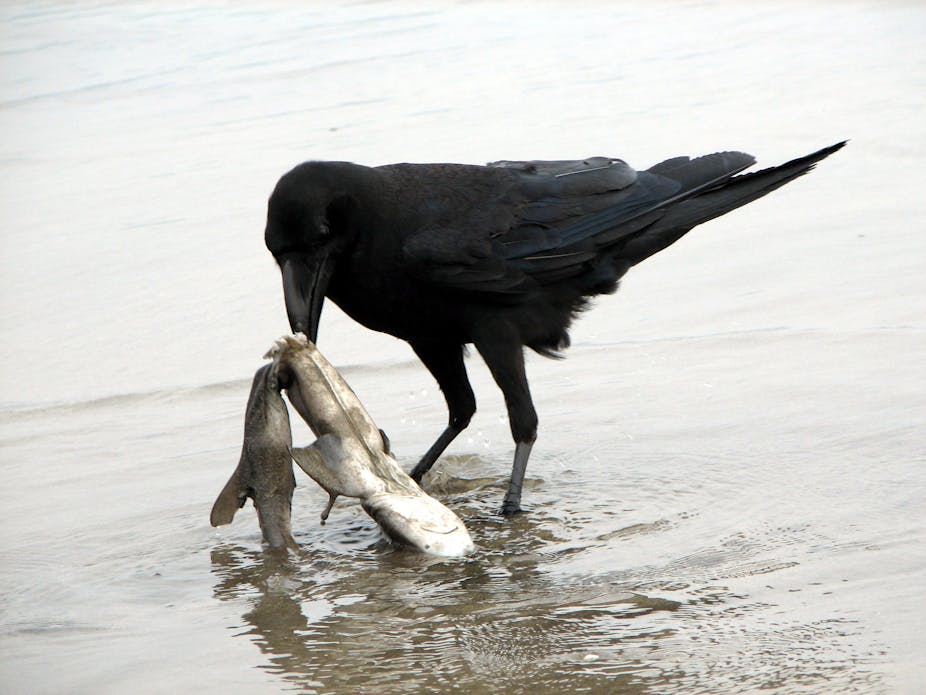Among birds, crows and ravens (or corvids) are the most intelligent. They have the largest brains for body size; they’re more like primates than birds. In fact, some people call them “flying monkeys”.
The family Corvidae originated from a forest ancestor in the Australian fragment of Gondwana. It’s thought that the mental abilities of the early corvids developed as a response to the challenges of adapting to a drying continent. As Australia drifted towards Asia, corvids dispersed and colonised the other continents.
What’s that bird?
The best-known corvids are the mostly-black crows and ravens. Ravens are the larger birds; crows the smaller. While most corvids are now found elsewhere, in Australia we have five species. They are all native (none introduced), all closely related and descended from a common ancestor.

The three ravens (Australian, Little and Forest) inhabit the temperate zone and sheep/wheat belt, and the two crows (Torresian and Little) inhabit the tropics and arid zone.
Generally speaking, the Torresian Crow is the urban corvid you will usually see north of Newcastle (NSW). The Australian Raven is the most common urban corvid in Sydney, Canberra and Perth; the Little Raven in Melbourne and Adelaide; and the Forest Raven in Hobart. The Little Crow is common in outback towns.
Corvid capacities
Corvids are highly social, curious (exploratory) and opportunistic, with exceptional long-term memory. They are renowned for their problem-solving ability in the lab and in the field.
Their mental ability is related to finding food, and to their complex social life that requires recognition of mates and the rules of a dominance hierarchy within the flock.

Corvids are particularly remarkable for their well-developed inner forebrain, especially the hippocampus. This is the part of the brain associated with spatial memory and problem-solving. Because of this, crows and ravens are the creatures with the highest capacity for memory and learning when viewing the landscape from the air.
Corvids learn, remember and use insight to solve challenges. They drop shellfish and nuts on hard surfaces to crack them. They hide and recover stored food (up to months later, in winter when food is otherwise scarce). And they use objects as tools and even form their own tools, such as spikes and hooks, to winkle out food from crevices.
Corvid defeats cane toad
Corvids recognise people carrying guns, they avoid traps, and they follow and harass large predators for food, or follow trappers and steal bait from traps. They have learnt to turn road-killed cane toads over and eat them from the belly, thus avoiding the dorsal poison glands.

Corvids have complex and sophisticated play behaviour. Most play is training for later life, and to show off their prowess to peers or potential mates. Corvids also play tricks on other species, and some play appears to be just for fun.
Corvids have complex vocal communication, possibly even basic language skills. Their repertoire is up to 80 or more call types, and includes vocal mimicry. They transfer knowledge to each other, and can count to about six.
Corvids and people
Corvids feature in the cave art of early humans. Their voices and actions reportedly stimulate human language and culture. Some research suggests that when humans interact with social crows, the things they see and learn can inspire their own rapid cultural evolution. Crows also seem to do things that people do (“talk” to each other, steal and hide things, use tools, “tease” other species, play), so it’s possible we’re all learning from one another.

The natural adaptability and intelligence of corvids has allowed them to exploit the many opportunities our wasteful urban life has created for them. In cities, where they are no longer shot, they have almost lost their fear of people, and brazenly raid rubbish bins and garbage dumps, spreading rubbish from bins that are not crow-proof.
They steal poultry eggs when they can, and steal golf balls from fairways, in the mistaken belief the balls are eggs. Their large, noisy communal roosts in the suburbs can disturb people’s sleep at dawn. In lambing paddocks, they are often blamed for killing lambs, although they mostly clean up afterbirth and dead or moribund lambs.
As annoying as humans might find crows, there is also a lot to respect in this highly successful expat species. If we can grow to understand them better and modify our ways, we can minimise conflict and better appreciate these remarkable birds.

